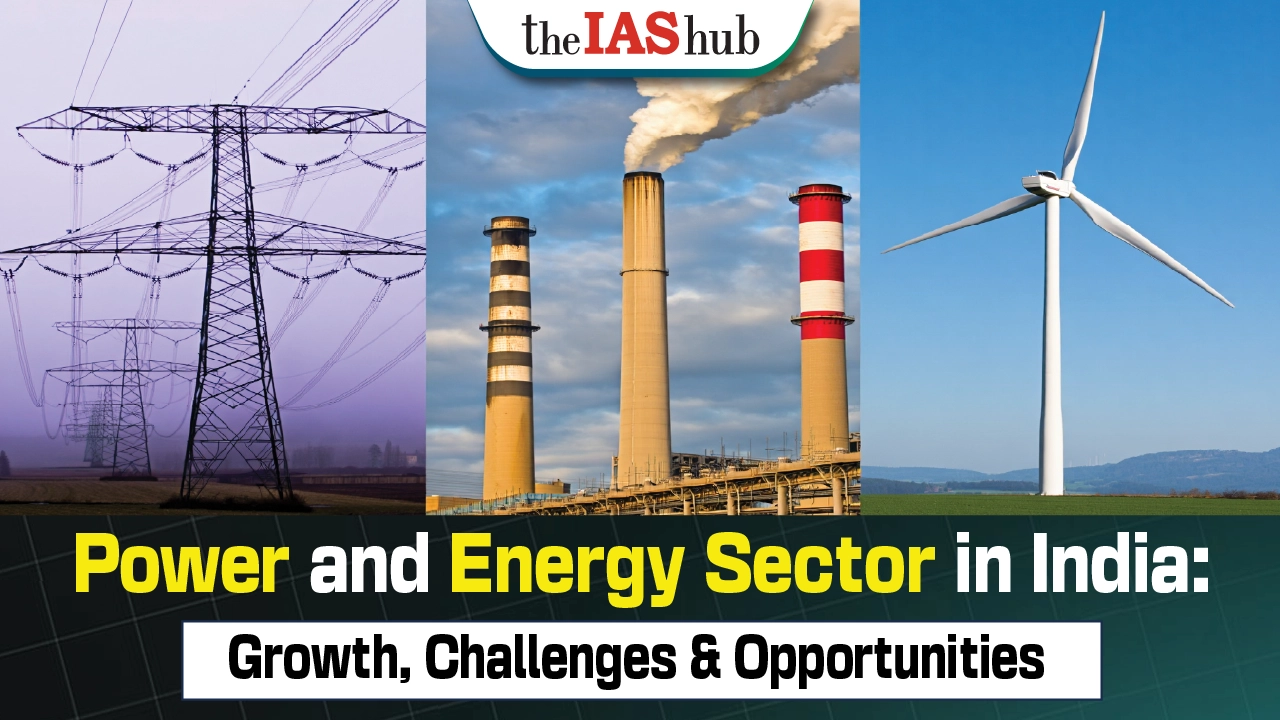Power and Energy Sector in India is one of the fastest-growing economies globally, has a burgeoning demand for power and energy. With a population exceeding 1.3 billion people and a rapidly developing economy, India's power and energy sector plays a crucial role in the country's growth and development.
Power Sector in India
The power sector in India encompasses the generation, transmission, and distribution of electricity, relying on a diverse mix of energy sources. These sources include coal, natural gas, hydroelectric, nuclear, wind, and solar energy.
- India ranks as the world's fifth-largest electricity producer, with Maharashtra leading among Indian states in energy generation.
- Electricity remains a critical driver for India's economic growth, with an elasticity ratio of 0.8, highlighting its significance. Renewable energy has gained traction, constituting 25% of the total installed capacity.
- India's power generation capacity has witnessed remarkable growth, currently standing at around 5 GW, with a target of reaching 450 GW by 2030.
- Coal-fired power plants dominate India's power generation, accounting for over 65% of the installed capacity.
- India has set ambitious targets for 450 GW of renewable energy by 2030, including 280 GW of solar, 140 GW of wind, 10 GW of biomass, and 5 GW of small hydropower projects.
- The government is also encouraging energy-efficient technologies like LED lighting and smart meters to improve energy consumption and efficiency.
- Initiatives such as the National Solar Mission, Wind Energy Mission, Smart Cities Mission, and UJALA scheme aim to promote renewable energy and energy-efficient technologies.
|
India's Renewable Energy Target of 50% by 2030 May be Achieved Early:
- While India may have internationally committed to half its installed electricity being sourced from renewable sources by 2030, an estimate of the country’s projected power needs by the Central Electricity Authority (CEA) in June 2023, suggested that this target may be achieved early, by 2026-27.
- The National Electricity Plan (NEP) prepared by the CEA is a five-year plan that assesses India’s current electricity needs, projected growth, power sources, and challenges.
- The voluminous document notes that “…the share of non-fossil based capacity is likely to increase to 57.4% by the end of 2026-27 and may likely to further increase to 68.4% by the end of 2031-32 from around 42.5% as on April 2023.”
|
Energy Sector in India
The energy sector in India encompasses the production and distribution of petroleum products, natural gas, and coal. India heavily relies on imports to meet its energy needs, with crude oil constituting over 80% of total energy imports. Efforts have been made to develop the natural gas infrastructure in recent years.
- The government has launched the City Gas Distribution (CGD) project to provide piped natural gas to households, industries, and vehicles.
- Compressed natural gas (CNG) is being promoted as a cleaner and cheaper alternative to petrol and diesel.
- Coal continues to play a significant role in India's energy sector, contributing to over 70% of electricity generation.
- Clean coal technologies such as supercritical and ultra-supercritical power plants are being adopted to improve efficiency and reduce emissions.
Challenges in Power and Energy Sector in India
- Fuel Security: Concerns about fuel availability and dependency on imported coal inhibit thermal capacity expansion.
- Transmission Losses: High distribution-line losses in the power sector increase the demand-supply gap.
- State Discoms' Financial Health: Debt accrual due to populist tariffs and operational inefficiencies harm the financial state of Discoms.
- Outdated Infrastructure: Ageing power plants and transmission networks impede growth and transmission efficiency.
- Under-procurement of Power: Limited fuel, financial strain, and high AT&C losses lead to reduced demand forecasts by State Discoms.
- Interstate Disputes: Disputes over river management affect hydroelectric plants and restrict power transfer between states.
- Financing Environment: Rising lending rates lead to project cost overruns and higher tariffs.
- Policy Paralysis: Micro-level policies need alignment with overarching policies like the Electricity Act of 2003 and National Electricity Policy.
Role of the Power and Energy Sector in India's Growth
- The government's emphasis on renewable energy and energy efficiency provides significant opportunities for private sector investment in clean energy technologies.
- Addressing challenges such as inadequate infrastructure and environmental concerns is essential for sustainable growth and development in the sector.
Sources
- Traditional and Renewable Energy: India has a vast and diverse power and energy sector. It relies on traditional sources like coal, oil, and natural gas, as well as renewable energy sources like solar, wind, and hydropower.
- Transition towards Renewable Energy: To meet increasing energy demands and reduce carbon footprint, India has set ambitious targets to achieve 450 GW of renewable energy capacity by 2030.
Importance in Economic Growth
- Oil and Gas Industry: The energy sector in India is crucial for economic growth. It encompasses oil and gas exploration, production, refining, and distribution.
- Consumption and Import: India ranks as the world's third-largest consumer of crude oil and the fourth-largest importer of liquefied natural gas (LNG).
- Dominance and Private Participation: State-owned companies like ONGC, GAIL, and Indian Oil Corporation dominate the sector, while the private sector also contributes significantly, particularly in refining and marketing.
- Catalyst for Development: The power and energy sector drives the growth of industries, agriculture, and domestic needs, highlighting its importance in India's economic development.
- Investment Opportunities: Sector in India offers significant opportunities for investment and growth, given the expected doubling of energy demand by 2040 and the potential for renewable energy development.
Government Initiatives for the Power and Energy Sector in India
Ujwal DISCOM Assurance Yojana (UDAY)
- Objective: To facilitate the financial turnaround and revival of power distribution firms (DISCOMs)
- UDAY aims to restructure DISCOMs' debt of Rs 4.3 lakh crore, reduce power theft, and align customer tariffs with the cost of providing electricity.
- It offers DISCOMs the opportunity to break even within the next two to three years through four main initiatives - improving operational efficiencies, lowering power costs, reducing interest costs, and enforcing financial discipline.
Debt Relief for DISCOMs
- As part of the program, state governments, which own the DISCOMs, can take over 75% of their debt as of September 30, 2015, and repay lenders by selling bonds.
- The remaining 25% of the debt will be covered by DISCOMs through the issuance of bonds.
Deendayal Upadhyaya Gram Jyoti Yojana (DUGJY)
- The Ministry of Power aims to provide power to 18,500 villages within three years under the Deendayal Upadhyaya Gram Jyoti Yojana (DUGJY).
- The scheme encompasses various components, including feeder separation, network strengthening, metering, microgrid and off-grid distribution network, and completion of rural electrification projects sanctioned under the previous Rajiv Gandhi Grameen Vidyutikaran Yojana (RGGVY).
Coal Mines (Special Provisions) Act, 2015
- The enactment of the Coal Mines (Special Provisions) Act, 2015 ensures the continuity of coal mining operations and production by allocating coal mines to winning bidders.
- This step helps address the issue of power generation fuel shortages.
Promoting Solar Rooftop Systems
- Government is launching two national-level programs to promote the development of solar rooftop systems - Grid Connected Rooftop & Small Solar Power Plants Program and Off-Grid & Decentralized Solar Applications.
Solar Power Park in Odisha
- Government of Odisha plans to build a 1,000-MW solar power park through a public-private partnership with an estimated expenditure of Rs 6,500 crore (US$ 1 billion).
Ultra-Mega Power Plants (UMPPs)
- The Indian government aims to construct five new UMPPs using plug-and-play technology, with an approximate cost of Rs 1 lakh crore. They are coal-fired thermal power plants with a capacity of 4,000 megawatts.
- The auctioning of coal blocks under the "plug and play" approach, after obtaining necessary clearances, aims to expedite and streamline mining activities and ensure better valuation.
- The Power Finance Corporation (PFC) serves as the nodal organization for UMPPs.
Saubhagya
- Government of India launched the Pradhan Mantri Sahaj Bijli Har Ghar Yojana – Saubhagya in October, 2017 with the objective to achieve universal household electrification for providing electricity connections to all willing un-electrified households in rural areas and all willing poor households in urban areas in the country.
Conclusion
The power and energy sector in India presents significant opportunities for growth, driven by increasing demand, government initiatives, and a focus on renewable energy. The government's commitment to sustainable energy solutions and continuous investments in the sector contribute to its ongoing development and transformation.











